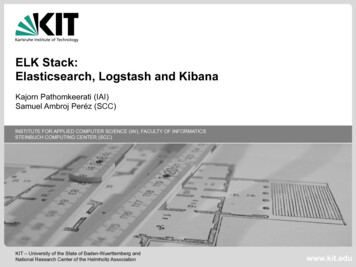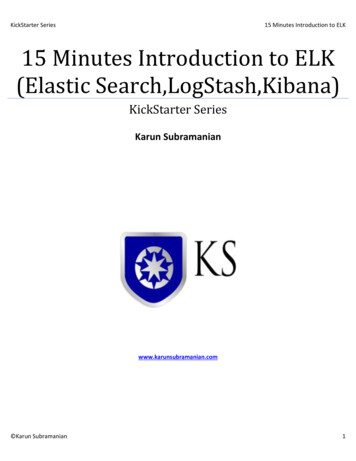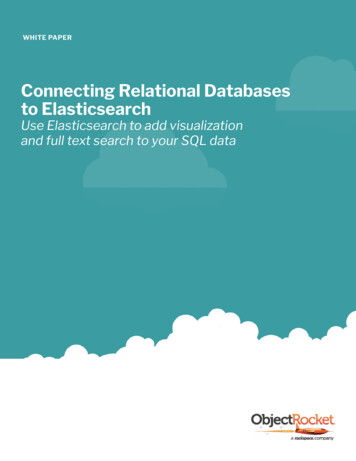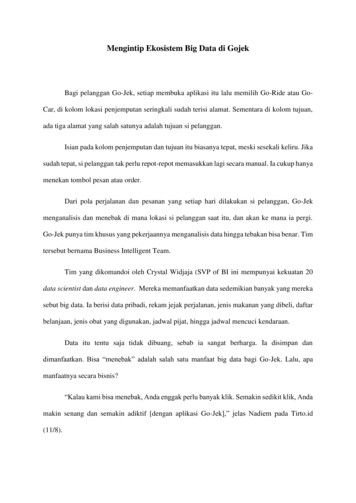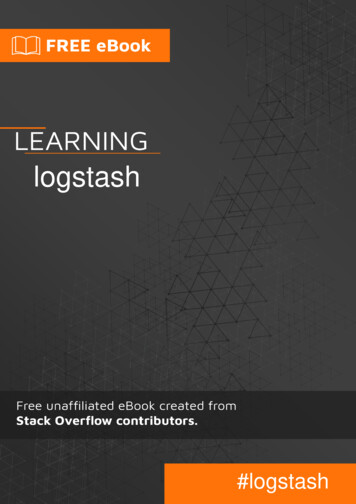
Transcription
logstash#logstash
Table of ContentsAbout1Chapter 1: Getting started with logstash2Remarks2Examples2Installation or Setup2A basic, complete Syslog example2Outputting to ElasticSearch: multiple indices and mappings3Credits4
AboutYou can share this PDF with anyone you feel could benefit from it, downloaded the latest versionfrom: logstashIt is an unofficial and free logstash ebook created for educational purposes. All the content isextracted from Stack Overflow Documentation, which is written by many hardworking individuals atStack Overflow. It is neither affiliated with Stack Overflow nor official logstash.The content is released under Creative Commons BY-SA, and the list of contributors to eachchapter are provided in the credits section at the end of this book. Images may be copyright oftheir respective owners unless otherwise specified. All trademarks and registered trademarks arethe property of their respective company owners.Use the content presented in this book at your own risk; it is not guaranteed to be correct noraccurate, please send your feedback and corrections to info@zzzprojects.comhttps://riptutorial.com/1
Chapter 1: Getting started with logstashRemarksThis section provides an overview of what logstash is, and why a developer might want to use it.It should also mention any large subjects within logstash, and link out to the related topics. Sincethe Documentation for logstash is new, you may need to create initial versions of those relatedtopics.ExamplesInstallation or SetupDetailed instructions on getting logstash set up or installed.A basic, complete Syslog exampleGoing to its roots, Logstash has the ability to parse and store syslog data. This example shows abasic configuration that gets you to that.input {file {path ["/var/log/syslog","/var/log/auth.log"]type "syslog"}}filter {if [type] "syslog" {# Uses built-in Grok patterns to parse this standard formatgrok {match {"message" }}# Sets the timestamp of the event to the timestamp of recorded in the log-data# By default, logstash sets the timestamp to the time it was ingested.date {match [ "timestamp", "MMM d HH:mm:ss", "MMM dd HH:mm:ss" ]}}}output {# Outputs processed events to an elasticsearch instance local to the box.elasticsearch {hosts ["localhost"https://riptutorial.com/2
]}}Outputting to ElasticSearch: multiple indices and mappingsSometimes, you need to output to more than one index in ElasticSearch, or have a custommapping you want to apply to new indices as they roll in.There are two ways to apply a custom mapping. One way, is to upload an ElasticSearch template.See the ElasticSearch documentation for that. The other way is to specify a mapping in theelasticsearch {} output itself. That is what is shown here.output {if [type] 'metrics' {# The 'metrics' index rotates weekly.# The 'metrics-mapping.json' file defines the custom mappings.elasticsearch {hosts [ 'localhost' ]index "metrics-%{xxxx.ww}"manage template truetemplate "/etc/logstash/metrics-mapping.json"template overwrite true}}}This will output metrics events to metrics- indexes on ElasticSearch, which will rotate weekly usingthe ISO week. The template used for new indexes is defined as part of this configuration. Defininga template has the advantage of forcing the types of fields to a uniform type. This is useful inlarger configurations where multiple types may attempt to define a field as a slightly different datatype.This method is useful in staging and QA environments, as the ElasticSearch templates are definedby the LogStash code and don't have to be configured separately as part of the ElasticSearchcluster setup.Read Getting started with logstash online: gstarted-with-logstashhttps://riptutorial.com/3
CreditsS.NoChaptersContributors1Getting started withlogstashCommunity, sysadmin1138https://riptutorial.com/4
Outputting to ElasticSearch: multiple indices and mappings Sometimes, you need to output to more than one index in ElasticSearch, or have a custom mapping you want to apply to new indices as they roll in. There are two ways to apply a custom mapping. One way, is to upload an ElasticSearch template. See t

